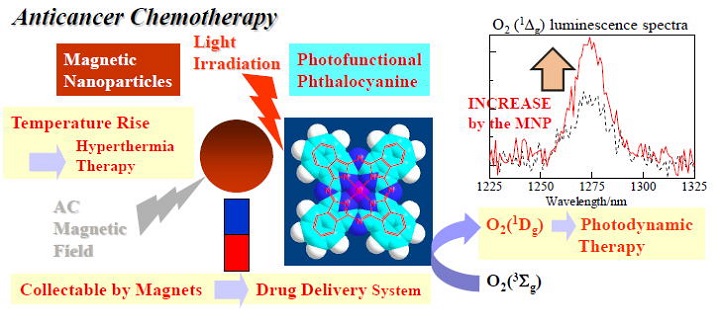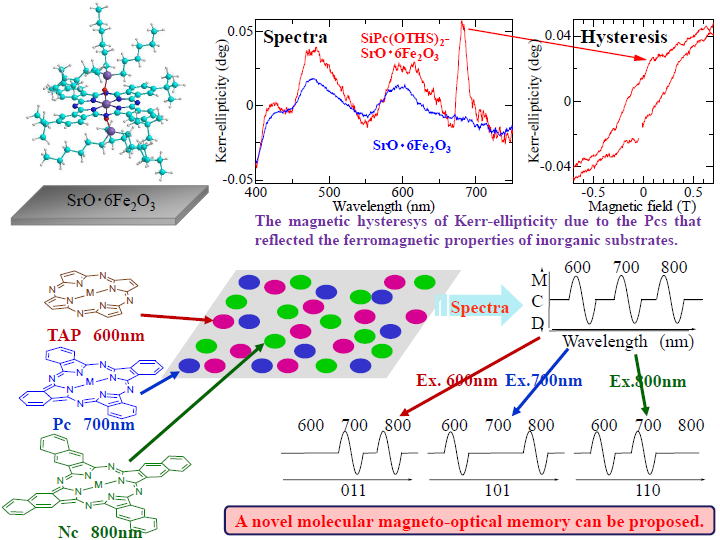Control of Solid-State Properties of Phthalocyanines
[1] Singlet Oxygen Generation
Phthalocyanine (Pc) derivatives have attracted considerable attention from the viewpoint of their various applications. Pcs tend to form aggregates because of their large π-conjugated systems that provide their strong π-π interactions. The π-π interactions in the solid state, i.e. crystals and thin layers, induce useful conductivity, which is applicable to semiconductors or photoconductors, but they also have disadvantages in terms of reducing the monomeric photophysical properties, i.e. the sharp Q absorption band, intense fluorescence, and ability for singlet-oxygen (1Δg) generation.
Singlet oxygen (1Δg) produced by the energy transfer from Pcs in the excited triplet (T1) state to triplet molecular oxygen (3Σg) is useful for photodynamic cancer therapy, photooxidation of toxic molecules, and photoproduction of important intermediates for other chemicals. Since solid photocatalysts based on red-light active Pcs have several advantages, i.e. the wider variation of reaction media, selective excitation of Pcs, and easy removal by filtration, it is important to realize that solid materials based on Pc complexes have a high ability for singlet oxygen generation. Therefore, solid-material-supported (silica gel or polymer) Pcs have been investigated.

[2] Molecular Magneto-Optical Materials
Molecular magnetism has recently been utilized not only for achieving new functions coupled with photochemistry but also for improving luminescent materials. For example, photoinduced magnetization observed in Prussian blue analogues originates from both the charge transfer and the spin crossover between the high spin and the low spin states, and therefore, such magnetization has potential for developing photochemically controllable magnetic materials.
In the case of electroluminescent materials, strong spin-orbit coupling in heavy metal complexes can increase the phosphorescent rate from the excited triplet state, which is efficiently formed from the electron-hole pair. Thus, the utilization of molecular magnetism with photofunctions is vital for developing novel scientific and technological applications.
In molecular magnetism, it is fundamental to realize novel memories or switches on the basis of molecular architectures and fine electronic controls. However, in the bulky molecular structures showing weak magnetic interactions, it is difficult to achieve molecular magnetic hysteresis at room temperature. Thus, hybridizations of functional molecules with ferromagnetic inorganic substrates have been investigated in order to combine molecular properties with inorganic ferromagnetic properties.
In this study, we reported the first observation of molecular magneto-optical effects due to the π-conjugated system with local-field- induced magnetic hysteresis in the visible region at room temperature. We prepared thin films on ferromagnetic substrates (Ni and SrO・6Fe2O3) using ditrihexylsiloxy(tetra-tert-butyl-phthalocyanato)silicon (SiPc(OTHS)2), since its surrounding substituents prevent both the aggregation and the direct interaction with the ferromagnetic substrates. In the case of SiPc(OTHS)2 on the SrO・6Fe2O3 substrate, the magneto-optical signal (680 nm) due to SiPc(OTHS)2 exhibits remanence and coercivity but does not exhibit saturation even at |1| T. The coercivity reflects the ferromagnetic character of SrO・6Fe2O3 , while the observed unsaturation is similar to that of SiPc(OTHS)2 on the Al substrate. Thus, we succeeded in admixing the magneto-optical effects of the diamagnetic Pcs with the magnetic hysteresis due to the ferromagnetic substrate. To the best of our knowledge, this is the first observation of the magnetic hysteresis loop of magneto-optical effects based on &pi-conjugated system in the visible region at room temperature.
For the future prospects, we proposed a concept for novel molecular magneto-optical memory. Tetraazaporphyrin (TAP, Q-band at 600 nm), Pc (Q-band at 700 nm), and naphthalocyanine (Nc, Q-band at 800 nm) complexes are painted on each magnetic domain of the magnetic substrate, which provides magneto-optical signals (1,1,1) by magnetization. For example, when TAP is selectively irradiated by a 600 nm laser, both the magnetization of the magnetic domain painted by TAP and the magneto-optical effect due to TAP disappear because of the thermomagnetic effect (the magneto-optical signal becomes (0,1,1)). Thus, by employing N kinds of dyes, 2N information can be memorized.

Related Papers
[1] Singlet Oxygen Generation
-
Kazuyuki Ishii
"Development of Solid Catalysts Based on Phthalocyanines Generating Singlet Oxygen"
Seisan-Kenkyu, 61, 83-86 (2009). -
K. Ozawa, K. Ishii
"Photophysical and Magnetic Properties of Magnetic Silica Gel Supported Silicon Phthalocyanine Complexes"
Phys. Chem. Chem. Phys., 11, 1019 (2009). -
K. Ishii, Y. Kikukawa, M. Shiine, N. Kobayashi, T. Tsuru, Y. Sakai, A. Sakoda
"Synthesis and Photophysical Properties of Silica Gel-Supported Photofunctional Silicon Phthalocyanine Complexes"
Eur. J. Inorg. Chem., 2975 (2008). -
K. Ishii, M. Shiine, Y. Kikukawa, N. Kobayashi, T. Shiragami, J. Matsumoto, M. Yasuda, H. Suzuki, H. Yokoi
"Silica Gel-Supported Photofunctional Silicon Phthalocyanine Complexes: Photodesorption of Molecular Oxygen by Singlet Oxygen Generation"
Chem. Phys. Lett., 448, 264 (2007).
[2] Molecular Magneto-Optical Materials
-
M. Karasawa, K. Ishii
"Transient absorption studies on photothermal energy transfer and heat dissipation: Phthalocyanine-based thin films on Bi, Al-substituted DyIG substrates"
Chem. Phys. Lett., 704, 1 (2018). -
M. Karasawa, K. Ishii
"Pulsed laser induced heat transfer from a phthalocyanine-based thin film to a Bi, Al-substituted DyIG substrate: photothermal demagnetization observed by magnetic circular dichroism and numerical analysis"
Phys. Chem. Chem. Phys., 20, 12241 (2018). -
M. Karasawa, K. Ishii
"Magnetic Hysteresis of Molecular Faraday Effects of Phthalocyanine-Based Thin Films on Bi, Al-Substituted DyIG Substrates at Room Temperature and Demagnetization of the Ferrimagnetic Substrates by Photothermal Effects of Phthalocyanines"
J. Phys. Chem. C, 120, 21811 (2016). -
Kazuyuki Ishii
"Novel Photofunctionalizations of Phthalocyanine Complexes by Combining with Inorganic Magnetic Materials"
Kagaku-Kogyo, 60, 629-633 (2009). -
K. Ishi, K. Ozawa
"Local-Field-Induced Effective Magnetic Hysteresis of Molecular Magneto-OpticalEffects in the Visible Region at Room Temperature : Phthalocyanine Thin Films on Ferromagnetic Inorganic Substrates"
J. Phys. Chem. C, 43, 18897 (2009). -
K. Ishii, H. Itoya, H. Miwa, N. Kobayashi
"Selective Detection of minor Prototropic Tautomers in Low-Symmetry Tetraazaporphyrin Derivatives by the Combined Use of Electronic Absorption, MCD, and CI Calculations"
Chem. Commun., 36, 4586 (2005). -
N. Kobayashi, J. Mack, K. Ishii, M. J. Stillman
"Electronic Structure of Reduced Symmetry Peripheral Fused-Ring-Substituted Phthalocyanines"
Inorg. Chem., 41, 5350 (2002). -
K. Ishii, N. Kobayashi, T. Matsuo, M. Tanaka, A. Sekiguchi
"Observation of the Predicted Negative Faraday A MCD Term in a Cyclobutadiene Dianion"
J. Am. Chem. Soc., 123, 5356 (2001). -
K. Ishii, Y. Hirose, N. Kobayashi
"Electronic Absorption, MCD and Fluorescence Studies on Phthalocyaninatosilicon Covalently Linked to One or Two TEMPO Radicals"
J. Porphyrins Phthalocyanines, 3, 439 (1999).
